Joint Ventures in Australian Mining: Challenges and Manager Roles
VerifiedAdded on 2023/06/15
|12
|2964
|113
Report
AI Summary
This report provides an overview of joint ventures in the Australian mining industry, where mineral resources are owned and governed by the state or territory. It examines the reasons why mining companies enter into joint venture arrangements, highlighting that these ventures can be contractual or corporate, each with its own advantages and legal considerations. The report also addresses the issues encountered between junior and major mining firms, such as unequal involvement, differences in opinion and management styles, and corporate culture clashes. Furthermore, it details the obligations of a manager in a joint venture agreement, emphasizing the importance of integrating the business, promoting management control, and acting in the best interest of all shareholders while avoiding explicit domination by one participant. The manager is accountable for the success and failure of the project.

Running head: JOINT VENTURE
Joint Venture
Name of the Student
Name of the University
Authors Note
Course ID
Joint Venture
Name of the Student
Name of the University
Authors Note
Course ID
Paraphrase This Document
Need a fresh take? Get an instant paraphrase of this document with our AI Paraphraser
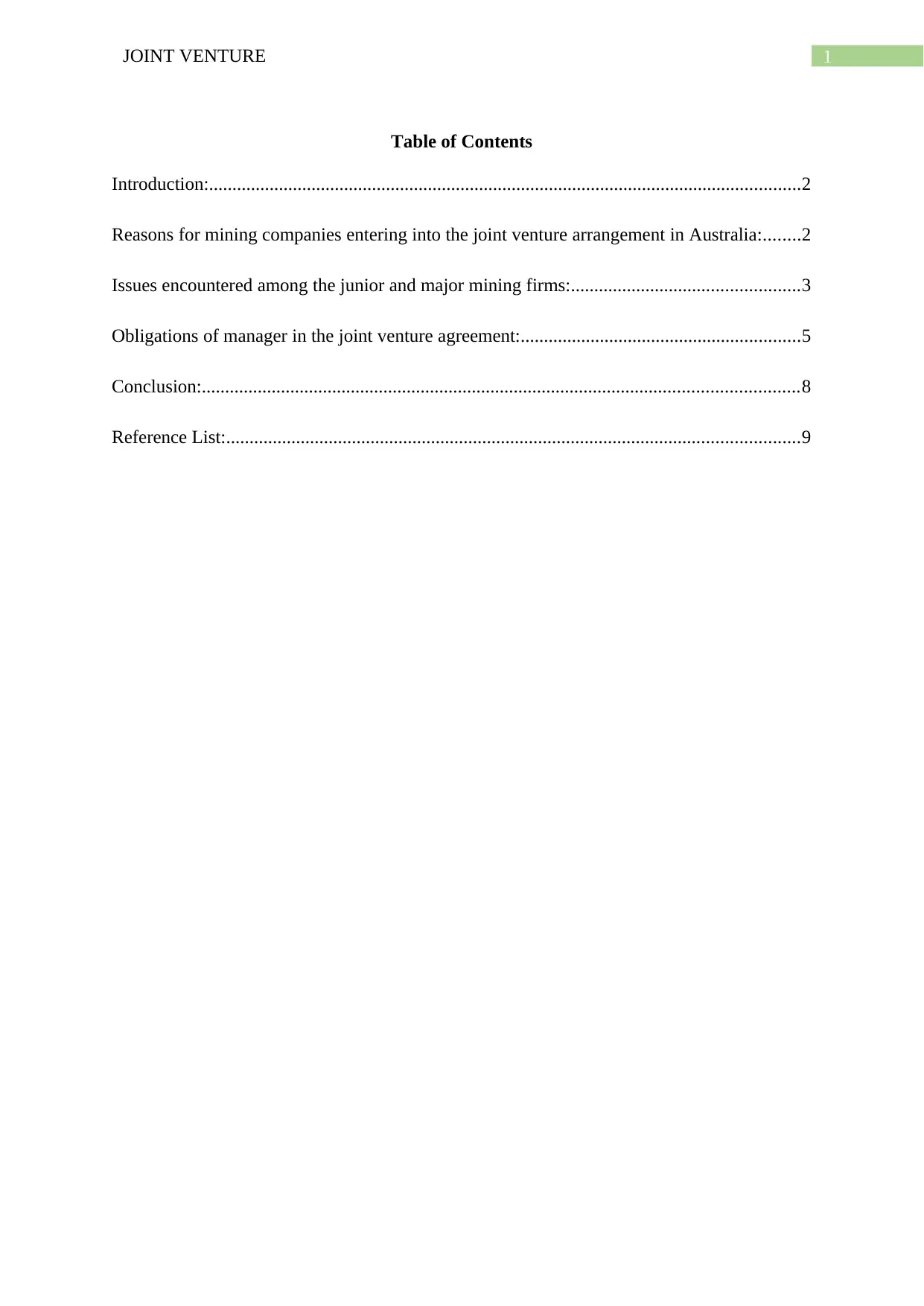
1JOINT VENTURE
Table of Contents
Introduction:...............................................................................................................................2
Reasons for mining companies entering into the joint venture arrangement in Australia:........2
Issues encountered among the junior and major mining firms:.................................................3
Obligations of manager in the joint venture agreement:............................................................5
Conclusion:................................................................................................................................8
Reference List:...........................................................................................................................9
Table of Contents
Introduction:...............................................................................................................................2
Reasons for mining companies entering into the joint venture arrangement in Australia:........2
Issues encountered among the junior and major mining firms:.................................................3
Obligations of manager in the joint venture agreement:............................................................5
Conclusion:................................................................................................................................8
Reference List:...........................................................................................................................9
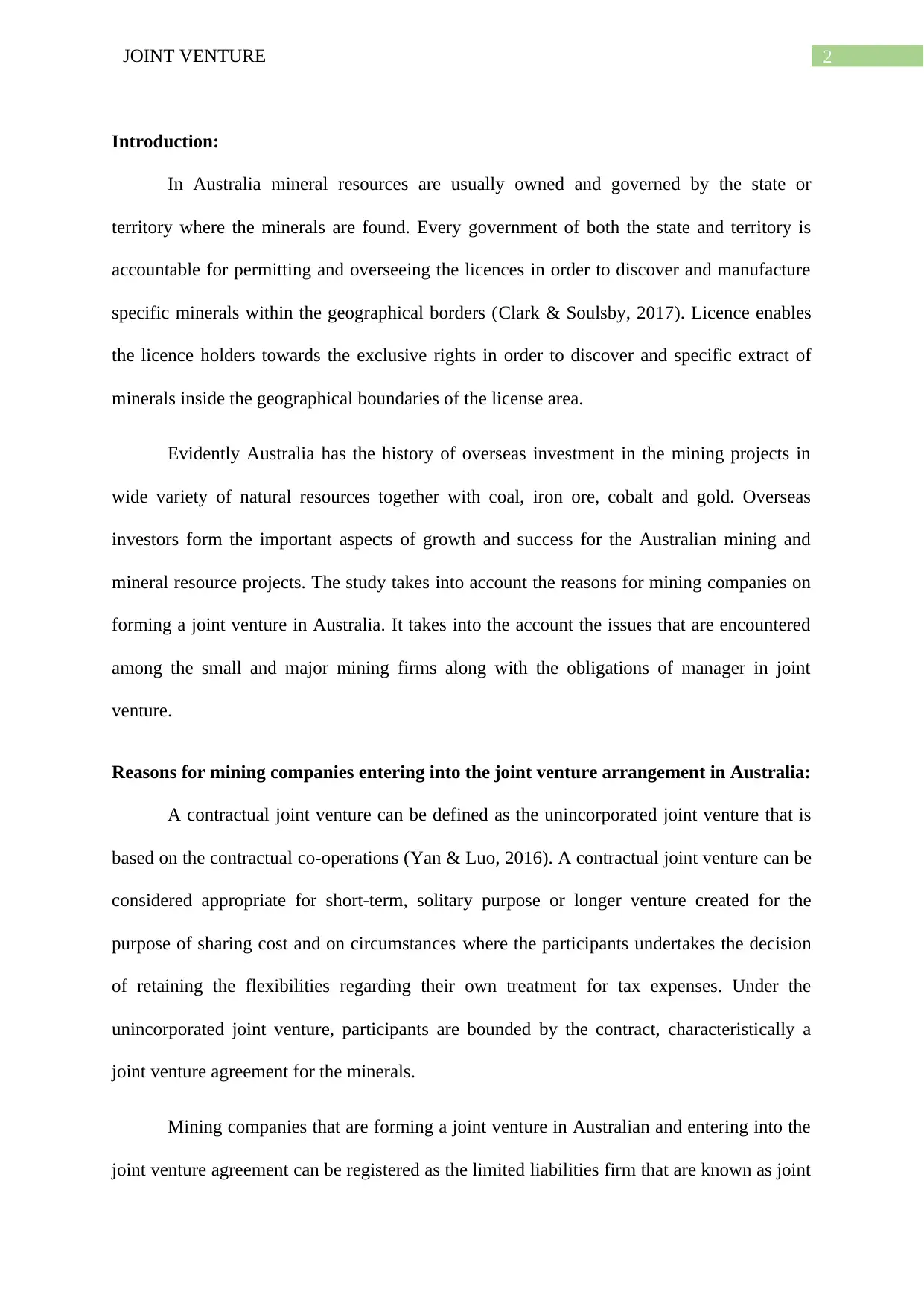
2JOINT VENTURE
Introduction:
In Australia mineral resources are usually owned and governed by the state or
territory where the minerals are found. Every government of both the state and territory is
accountable for permitting and overseeing the licences in order to discover and manufacture
specific minerals within the geographical borders (Clark & Soulsby, 2017). Licence enables
the licence holders towards the exclusive rights in order to discover and specific extract of
minerals inside the geographical boundaries of the license area.
Evidently Australia has the history of overseas investment in the mining projects in
wide variety of natural resources together with coal, iron ore, cobalt and gold. Overseas
investors form the important aspects of growth and success for the Australian mining and
mineral resource projects. The study takes into account the reasons for mining companies on
forming a joint venture in Australia. It takes into the account the issues that are encountered
among the small and major mining firms along with the obligations of manager in joint
venture.
Reasons for mining companies entering into the joint venture arrangement in Australia:
A contractual joint venture can be defined as the unincorporated joint venture that is
based on the contractual co-operations (Yan & Luo, 2016). A contractual joint venture can be
considered appropriate for short-term, solitary purpose or longer venture created for the
purpose of sharing cost and on circumstances where the participants undertakes the decision
of retaining the flexibilities regarding their own treatment for tax expenses. Under the
unincorporated joint venture, participants are bounded by the contract, characteristically a
joint venture agreement for the minerals.
Mining companies that are forming a joint venture in Australian and entering into the
joint venture agreement can be registered as the limited liabilities firm that are known as joint
Introduction:
In Australia mineral resources are usually owned and governed by the state or
territory where the minerals are found. Every government of both the state and territory is
accountable for permitting and overseeing the licences in order to discover and manufacture
specific minerals within the geographical borders (Clark & Soulsby, 2017). Licence enables
the licence holders towards the exclusive rights in order to discover and specific extract of
minerals inside the geographical boundaries of the license area.
Evidently Australia has the history of overseas investment in the mining projects in
wide variety of natural resources together with coal, iron ore, cobalt and gold. Overseas
investors form the important aspects of growth and success for the Australian mining and
mineral resource projects. The study takes into account the reasons for mining companies on
forming a joint venture in Australia. It takes into the account the issues that are encountered
among the small and major mining firms along with the obligations of manager in joint
venture.
Reasons for mining companies entering into the joint venture arrangement in Australia:
A contractual joint venture can be defined as the unincorporated joint venture that is
based on the contractual co-operations (Yan & Luo, 2016). A contractual joint venture can be
considered appropriate for short-term, solitary purpose or longer venture created for the
purpose of sharing cost and on circumstances where the participants undertakes the decision
of retaining the flexibilities regarding their own treatment for tax expenses. Under the
unincorporated joint venture, participants are bounded by the contract, characteristically a
joint venture agreement for the minerals.
Mining companies that are forming a joint venture in Australian and entering into the
joint venture agreement can be registered as the limited liabilities firm that are known as joint
⊘ This is a preview!⊘
Do you want full access?
Subscribe today to unlock all pages.

Trusted by 1+ million students worldwide
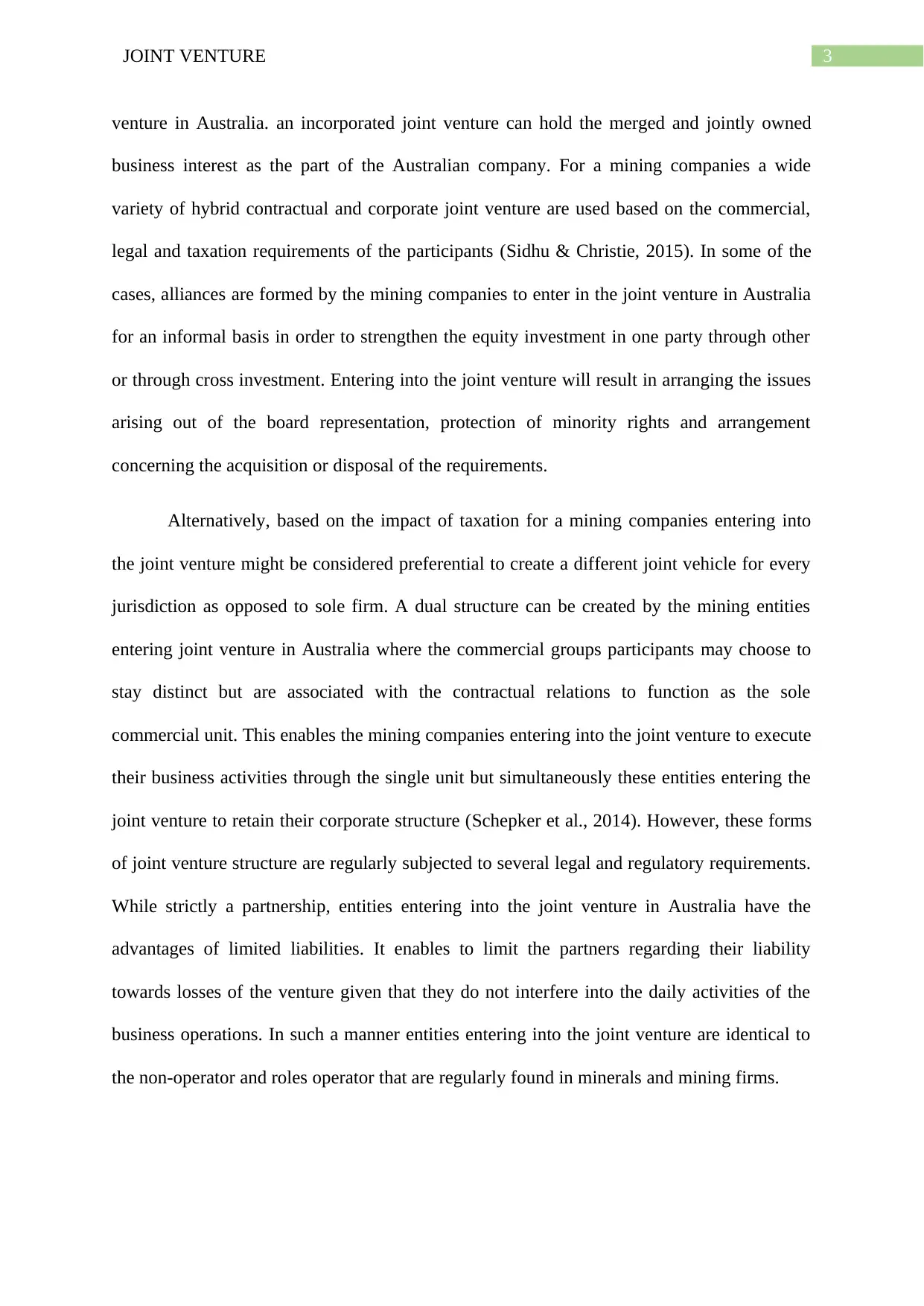
3JOINT VENTURE
venture in Australia. an incorporated joint venture can hold the merged and jointly owned
business interest as the part of the Australian company. For a mining companies a wide
variety of hybrid contractual and corporate joint venture are used based on the commercial,
legal and taxation requirements of the participants (Sidhu & Christie, 2015). In some of the
cases, alliances are formed by the mining companies to enter in the joint venture in Australia
for an informal basis in order to strengthen the equity investment in one party through other
or through cross investment. Entering into the joint venture will result in arranging the issues
arising out of the board representation, protection of minority rights and arrangement
concerning the acquisition or disposal of the requirements.
Alternatively, based on the impact of taxation for a mining companies entering into
the joint venture might be considered preferential to create a different joint vehicle for every
jurisdiction as opposed to sole firm. A dual structure can be created by the mining entities
entering joint venture in Australia where the commercial groups participants may choose to
stay distinct but are associated with the contractual relations to function as the sole
commercial unit. This enables the mining companies entering into the joint venture to execute
their business activities through the single unit but simultaneously these entities entering the
joint venture to retain their corporate structure (Schepker et al., 2014). However, these forms
of joint venture structure are regularly subjected to several legal and regulatory requirements.
While strictly a partnership, entities entering into the joint venture in Australia have the
advantages of limited liabilities. It enables to limit the partners regarding their liability
towards losses of the venture given that they do not interfere into the daily activities of the
business operations. In such a manner entities entering into the joint venture are identical to
the non-operator and roles operator that are regularly found in minerals and mining firms.
venture in Australia. an incorporated joint venture can hold the merged and jointly owned
business interest as the part of the Australian company. For a mining companies a wide
variety of hybrid contractual and corporate joint venture are used based on the commercial,
legal and taxation requirements of the participants (Sidhu & Christie, 2015). In some of the
cases, alliances are formed by the mining companies to enter in the joint venture in Australia
for an informal basis in order to strengthen the equity investment in one party through other
or through cross investment. Entering into the joint venture will result in arranging the issues
arising out of the board representation, protection of minority rights and arrangement
concerning the acquisition or disposal of the requirements.
Alternatively, based on the impact of taxation for a mining companies entering into
the joint venture might be considered preferential to create a different joint vehicle for every
jurisdiction as opposed to sole firm. A dual structure can be created by the mining entities
entering joint venture in Australia where the commercial groups participants may choose to
stay distinct but are associated with the contractual relations to function as the sole
commercial unit. This enables the mining companies entering into the joint venture to execute
their business activities through the single unit but simultaneously these entities entering the
joint venture to retain their corporate structure (Schepker et al., 2014). However, these forms
of joint venture structure are regularly subjected to several legal and regulatory requirements.
While strictly a partnership, entities entering into the joint venture in Australia have the
advantages of limited liabilities. It enables to limit the partners regarding their liability
towards losses of the venture given that they do not interfere into the daily activities of the
business operations. In such a manner entities entering into the joint venture are identical to
the non-operator and roles operator that are regularly found in minerals and mining firms.
Paraphrase This Document
Need a fresh take? Get an instant paraphrase of this document with our AI Paraphraser
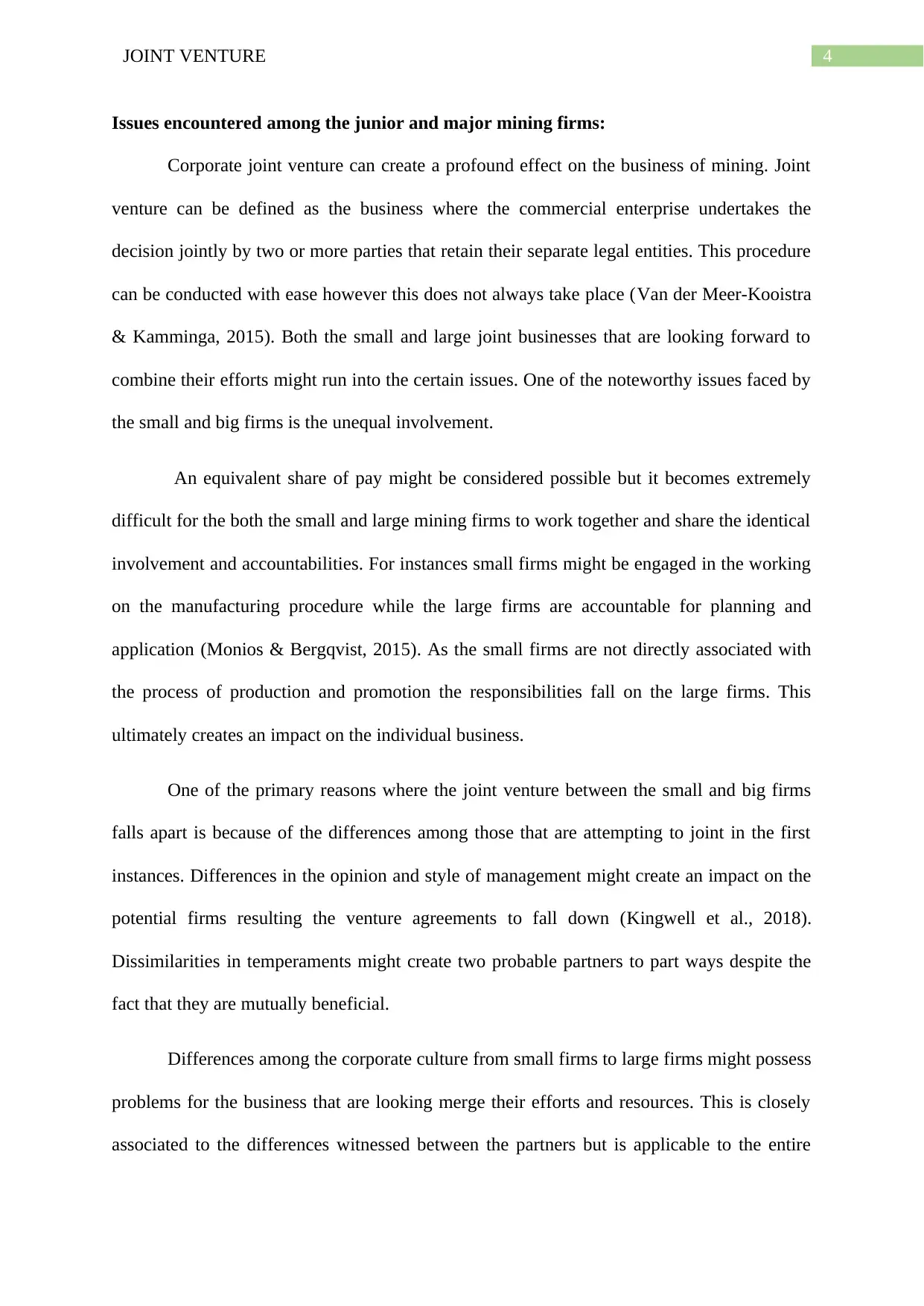
4JOINT VENTURE
Issues encountered among the junior and major mining firms:
Corporate joint venture can create a profound effect on the business of mining. Joint
venture can be defined as the business where the commercial enterprise undertakes the
decision jointly by two or more parties that retain their separate legal entities. This procedure
can be conducted with ease however this does not always take place (Van der Meer-Kooistra
& Kamminga, 2015). Both the small and large joint businesses that are looking forward to
combine their efforts might run into the certain issues. One of the noteworthy issues faced by
the small and big firms is the unequal involvement.
An equivalent share of pay might be considered possible but it becomes extremely
difficult for the both the small and large mining firms to work together and share the identical
involvement and accountabilities. For instances small firms might be engaged in the working
on the manufacturing procedure while the large firms are accountable for planning and
application (Monios & Bergqvist, 2015). As the small firms are not directly associated with
the process of production and promotion the responsibilities fall on the large firms. This
ultimately creates an impact on the individual business.
One of the primary reasons where the joint venture between the small and big firms
falls apart is because of the differences among those that are attempting to joint in the first
instances. Differences in the opinion and style of management might create an impact on the
potential firms resulting the venture agreements to fall down (Kingwell et al., 2018).
Dissimilarities in temperaments might create two probable partners to part ways despite the
fact that they are mutually beneficial.
Differences among the corporate culture from small firms to large firms might possess
problems for the business that are looking merge their efforts and resources. This is closely
associated to the differences witnessed between the partners but is applicable to the entire
Issues encountered among the junior and major mining firms:
Corporate joint venture can create a profound effect on the business of mining. Joint
venture can be defined as the business where the commercial enterprise undertakes the
decision jointly by two or more parties that retain their separate legal entities. This procedure
can be conducted with ease however this does not always take place (Van der Meer-Kooistra
& Kamminga, 2015). Both the small and large joint businesses that are looking forward to
combine their efforts might run into the certain issues. One of the noteworthy issues faced by
the small and big firms is the unequal involvement.
An equivalent share of pay might be considered possible but it becomes extremely
difficult for the both the small and large mining firms to work together and share the identical
involvement and accountabilities. For instances small firms might be engaged in the working
on the manufacturing procedure while the large firms are accountable for planning and
application (Monios & Bergqvist, 2015). As the small firms are not directly associated with
the process of production and promotion the responsibilities fall on the large firms. This
ultimately creates an impact on the individual business.
One of the primary reasons where the joint venture between the small and big firms
falls apart is because of the differences among those that are attempting to joint in the first
instances. Differences in the opinion and style of management might create an impact on the
potential firms resulting the venture agreements to fall down (Kingwell et al., 2018).
Dissimilarities in temperaments might create two probable partners to part ways despite the
fact that they are mutually beneficial.
Differences among the corporate culture from small firms to large firms might possess
problems for the business that are looking merge their efforts and resources. This is closely
associated to the differences witnessed between the partners but is applicable to the entire
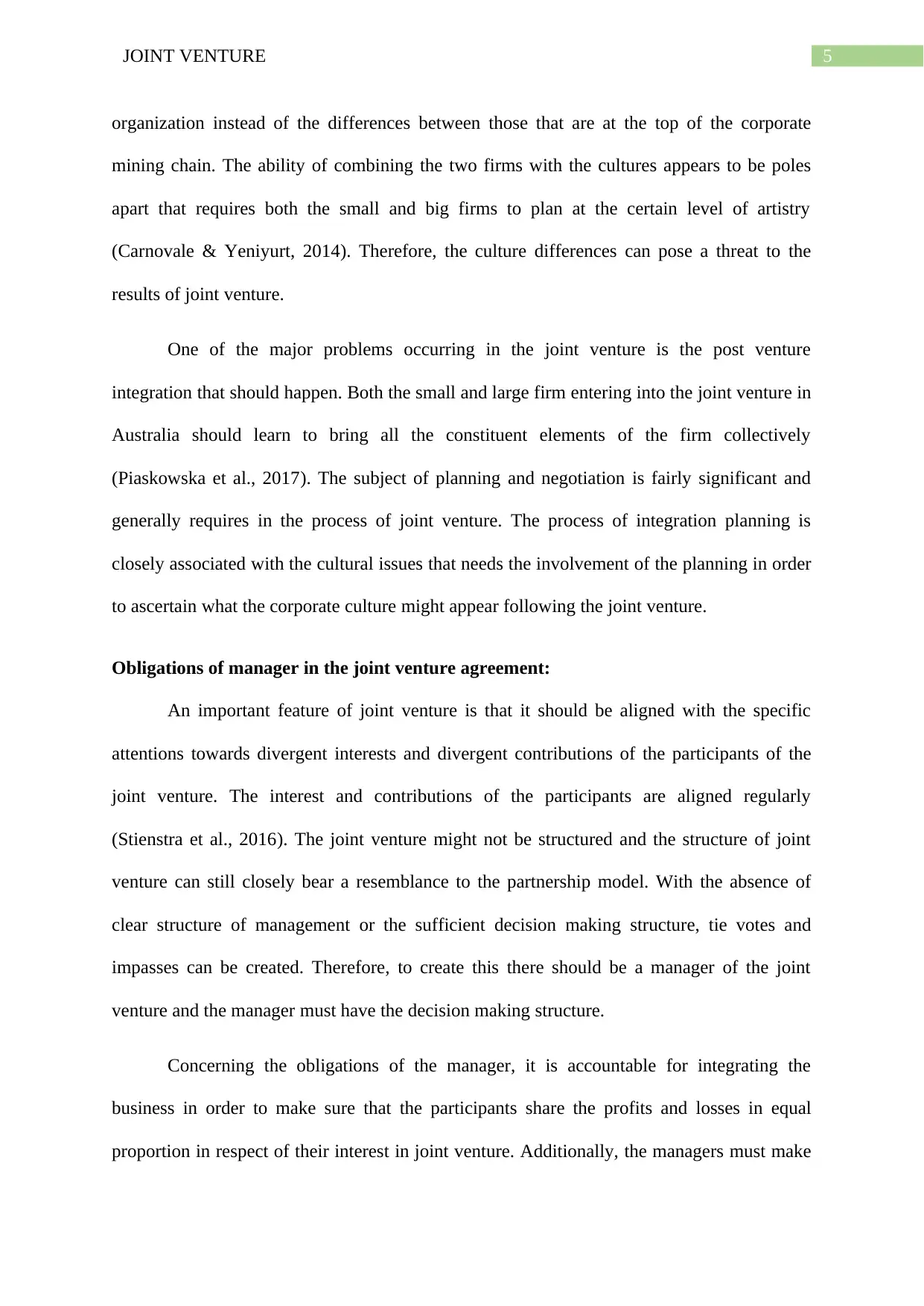
5JOINT VENTURE
organization instead of the differences between those that are at the top of the corporate
mining chain. The ability of combining the two firms with the cultures appears to be poles
apart that requires both the small and big firms to plan at the certain level of artistry
(Carnovale & Yeniyurt, 2014). Therefore, the culture differences can pose a threat to the
results of joint venture.
One of the major problems occurring in the joint venture is the post venture
integration that should happen. Both the small and large firm entering into the joint venture in
Australia should learn to bring all the constituent elements of the firm collectively
(Piaskowska et al., 2017). The subject of planning and negotiation is fairly significant and
generally requires in the process of joint venture. The process of integration planning is
closely associated with the cultural issues that needs the involvement of the planning in order
to ascertain what the corporate culture might appear following the joint venture.
Obligations of manager in the joint venture agreement:
An important feature of joint venture is that it should be aligned with the specific
attentions towards divergent interests and divergent contributions of the participants of the
joint venture. The interest and contributions of the participants are aligned regularly
(Stienstra et al., 2016). The joint venture might not be structured and the structure of joint
venture can still closely bear a resemblance to the partnership model. With the absence of
clear structure of management or the sufficient decision making structure, tie votes and
impasses can be created. Therefore, to create this there should be a manager of the joint
venture and the manager must have the decision making structure.
Concerning the obligations of the manager, it is accountable for integrating the
business in order to make sure that the participants share the profits and losses in equal
proportion in respect of their interest in joint venture. Additionally, the managers must make
organization instead of the differences between those that are at the top of the corporate
mining chain. The ability of combining the two firms with the cultures appears to be poles
apart that requires both the small and big firms to plan at the certain level of artistry
(Carnovale & Yeniyurt, 2014). Therefore, the culture differences can pose a threat to the
results of joint venture.
One of the major problems occurring in the joint venture is the post venture
integration that should happen. Both the small and large firm entering into the joint venture in
Australia should learn to bring all the constituent elements of the firm collectively
(Piaskowska et al., 2017). The subject of planning and negotiation is fairly significant and
generally requires in the process of joint venture. The process of integration planning is
closely associated with the cultural issues that needs the involvement of the planning in order
to ascertain what the corporate culture might appear following the joint venture.
Obligations of manager in the joint venture agreement:
An important feature of joint venture is that it should be aligned with the specific
attentions towards divergent interests and divergent contributions of the participants of the
joint venture. The interest and contributions of the participants are aligned regularly
(Stienstra et al., 2016). The joint venture might not be structured and the structure of joint
venture can still closely bear a resemblance to the partnership model. With the absence of
clear structure of management or the sufficient decision making structure, tie votes and
impasses can be created. Therefore, to create this there should be a manager of the joint
venture and the manager must have the decision making structure.
Concerning the obligations of the manager, it is accountable for integrating the
business in order to make sure that the participants share the profits and losses in equal
proportion in respect of their interest in joint venture. Additionally, the managers must make
⊘ This is a preview!⊘
Do you want full access?
Subscribe today to unlock all pages.

Trusted by 1+ million students worldwide
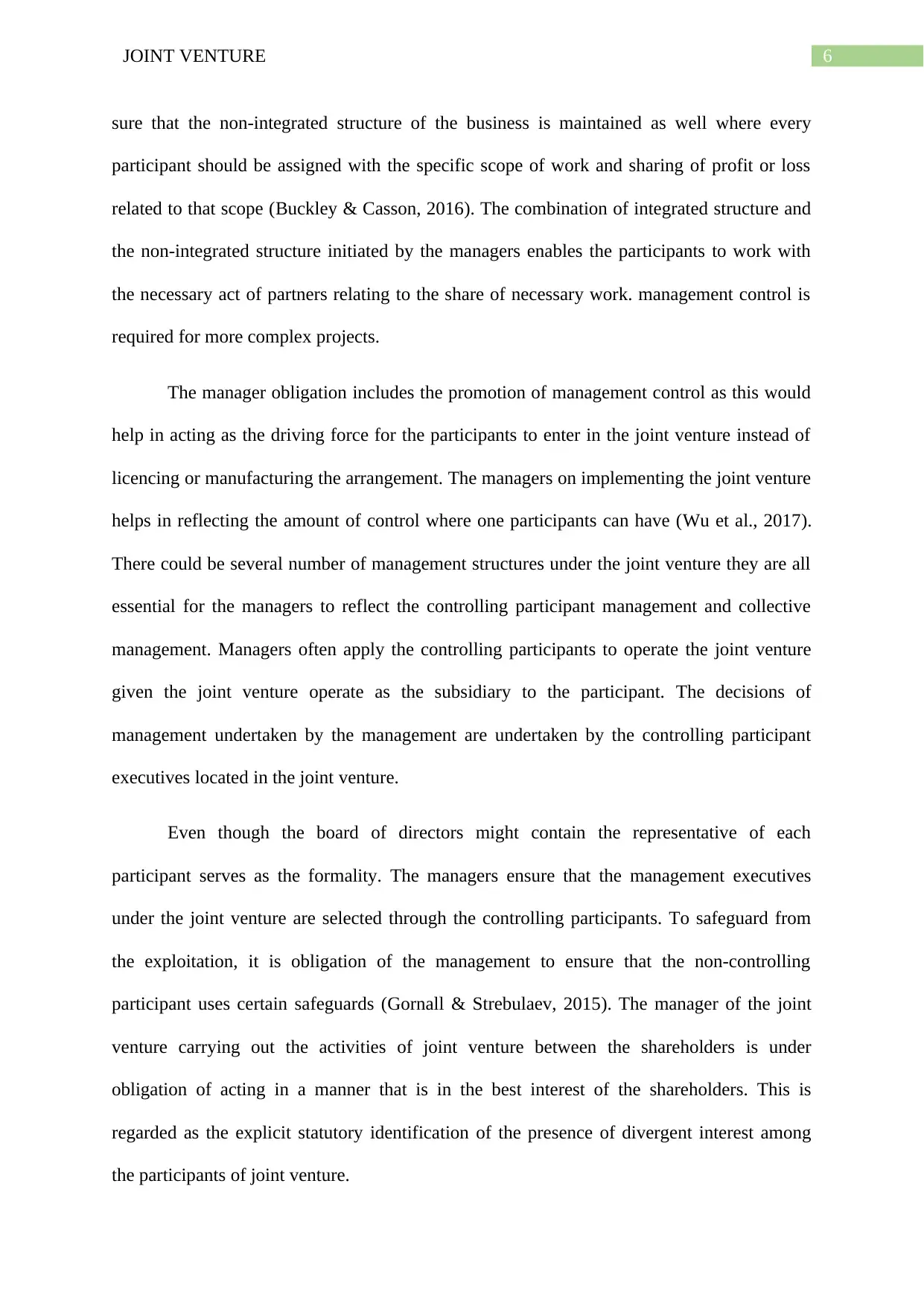
6JOINT VENTURE
sure that the non-integrated structure of the business is maintained as well where every
participant should be assigned with the specific scope of work and sharing of profit or loss
related to that scope (Buckley & Casson, 2016). The combination of integrated structure and
the non-integrated structure initiated by the managers enables the participants to work with
the necessary act of partners relating to the share of necessary work. management control is
required for more complex projects.
The manager obligation includes the promotion of management control as this would
help in acting as the driving force for the participants to enter in the joint venture instead of
licencing or manufacturing the arrangement. The managers on implementing the joint venture
helps in reflecting the amount of control where one participants can have (Wu et al., 2017).
There could be several number of management structures under the joint venture they are all
essential for the managers to reflect the controlling participant management and collective
management. Managers often apply the controlling participants to operate the joint venture
given the joint venture operate as the subsidiary to the participant. The decisions of
management undertaken by the management are undertaken by the controlling participant
executives located in the joint venture.
Even though the board of directors might contain the representative of each
participant serves as the formality. The managers ensure that the management executives
under the joint venture are selected through the controlling participants. To safeguard from
the exploitation, it is obligation of the management to ensure that the non-controlling
participant uses certain safeguards (Gornall & Strebulaev, 2015). The manager of the joint
venture carrying out the activities of joint venture between the shareholders is under
obligation of acting in a manner that is in the best interest of the shareholders. This is
regarded as the explicit statutory identification of the presence of divergent interest among
the participants of joint venture.
sure that the non-integrated structure of the business is maintained as well where every
participant should be assigned with the specific scope of work and sharing of profit or loss
related to that scope (Buckley & Casson, 2016). The combination of integrated structure and
the non-integrated structure initiated by the managers enables the participants to work with
the necessary act of partners relating to the share of necessary work. management control is
required for more complex projects.
The manager obligation includes the promotion of management control as this would
help in acting as the driving force for the participants to enter in the joint venture instead of
licencing or manufacturing the arrangement. The managers on implementing the joint venture
helps in reflecting the amount of control where one participants can have (Wu et al., 2017).
There could be several number of management structures under the joint venture they are all
essential for the managers to reflect the controlling participant management and collective
management. Managers often apply the controlling participants to operate the joint venture
given the joint venture operate as the subsidiary to the participant. The decisions of
management undertaken by the management are undertaken by the controlling participant
executives located in the joint venture.
Even though the board of directors might contain the representative of each
participant serves as the formality. The managers ensure that the management executives
under the joint venture are selected through the controlling participants. To safeguard from
the exploitation, it is obligation of the management to ensure that the non-controlling
participant uses certain safeguards (Gornall & Strebulaev, 2015). The manager of the joint
venture carrying out the activities of joint venture between the shareholders is under
obligation of acting in a manner that is in the best interest of the shareholders. This is
regarded as the explicit statutory identification of the presence of divergent interest among
the participants of joint venture.
Paraphrase This Document
Need a fresh take? Get an instant paraphrase of this document with our AI Paraphraser
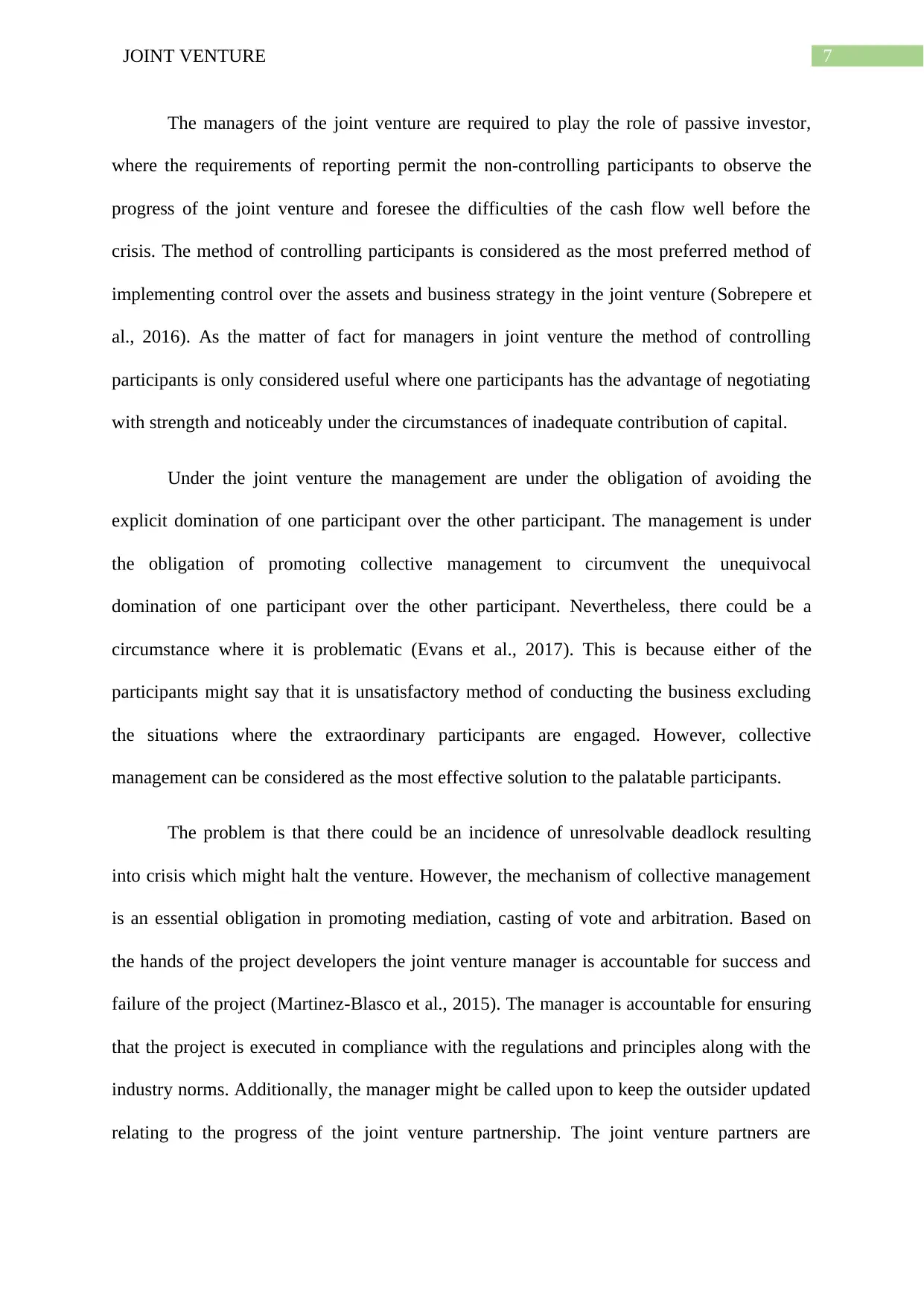
7JOINT VENTURE
The managers of the joint venture are required to play the role of passive investor,
where the requirements of reporting permit the non-controlling participants to observe the
progress of the joint venture and foresee the difficulties of the cash flow well before the
crisis. The method of controlling participants is considered as the most preferred method of
implementing control over the assets and business strategy in the joint venture (Sobrepere et
al., 2016). As the matter of fact for managers in joint venture the method of controlling
participants is only considered useful where one participants has the advantage of negotiating
with strength and noticeably under the circumstances of inadequate contribution of capital.
Under the joint venture the management are under the obligation of avoiding the
explicit domination of one participant over the other participant. The management is under
the obligation of promoting collective management to circumvent the unequivocal
domination of one participant over the other participant. Nevertheless, there could be a
circumstance where it is problematic (Evans et al., 2017). This is because either of the
participants might say that it is unsatisfactory method of conducting the business excluding
the situations where the extraordinary participants are engaged. However, collective
management can be considered as the most effective solution to the palatable participants.
The problem is that there could be an incidence of unresolvable deadlock resulting
into crisis which might halt the venture. However, the mechanism of collective management
is an essential obligation in promoting mediation, casting of vote and arbitration. Based on
the hands of the project developers the joint venture manager is accountable for success and
failure of the project (Martinez-Blasco et al., 2015). The manager is accountable for ensuring
that the project is executed in compliance with the regulations and principles along with the
industry norms. Additionally, the manager might be called upon to keep the outsider updated
relating to the progress of the joint venture partnership. The joint venture partners are
The managers of the joint venture are required to play the role of passive investor,
where the requirements of reporting permit the non-controlling participants to observe the
progress of the joint venture and foresee the difficulties of the cash flow well before the
crisis. The method of controlling participants is considered as the most preferred method of
implementing control over the assets and business strategy in the joint venture (Sobrepere et
al., 2016). As the matter of fact for managers in joint venture the method of controlling
participants is only considered useful where one participants has the advantage of negotiating
with strength and noticeably under the circumstances of inadequate contribution of capital.
Under the joint venture the management are under the obligation of avoiding the
explicit domination of one participant over the other participant. The management is under
the obligation of promoting collective management to circumvent the unequivocal
domination of one participant over the other participant. Nevertheless, there could be a
circumstance where it is problematic (Evans et al., 2017). This is because either of the
participants might say that it is unsatisfactory method of conducting the business excluding
the situations where the extraordinary participants are engaged. However, collective
management can be considered as the most effective solution to the palatable participants.
The problem is that there could be an incidence of unresolvable deadlock resulting
into crisis which might halt the venture. However, the mechanism of collective management
is an essential obligation in promoting mediation, casting of vote and arbitration. Based on
the hands of the project developers the joint venture manager is accountable for success and
failure of the project (Martinez-Blasco et al., 2015). The manager is accountable for ensuring
that the project is executed in compliance with the regulations and principles along with the
industry norms. Additionally, the manager might be called upon to keep the outsider updated
relating to the progress of the joint venture partnership. The joint venture partners are
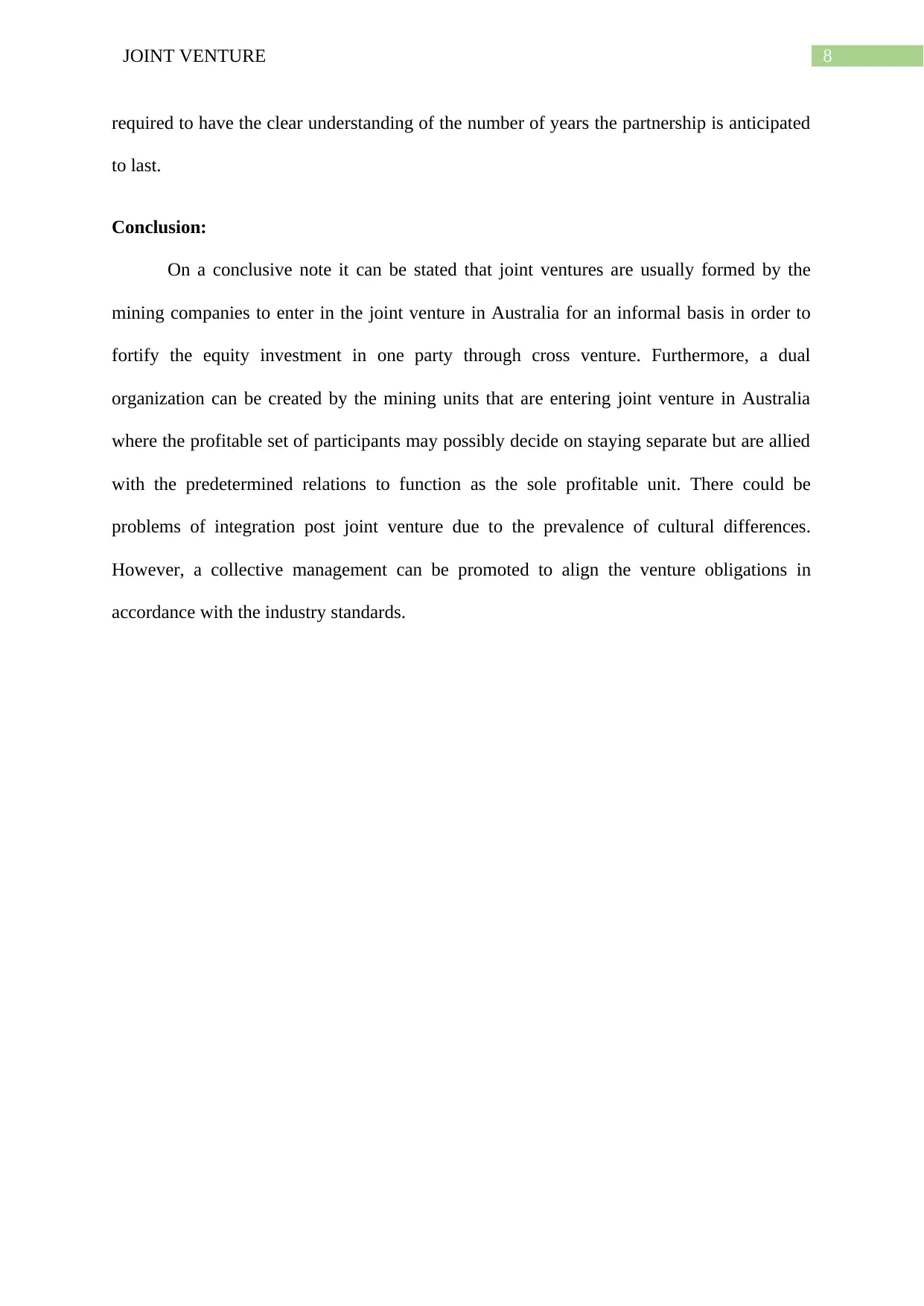
8JOINT VENTURE
required to have the clear understanding of the number of years the partnership is anticipated
to last.
Conclusion:
On a conclusive note it can be stated that joint ventures are usually formed by the
mining companies to enter in the joint venture in Australia for an informal basis in order to
fortify the equity investment in one party through cross venture. Furthermore, a dual
organization can be created by the mining units that are entering joint venture in Australia
where the profitable set of participants may possibly decide on staying separate but are allied
with the predetermined relations to function as the sole profitable unit. There could be
problems of integration post joint venture due to the prevalence of cultural differences.
However, a collective management can be promoted to align the venture obligations in
accordance with the industry standards.
required to have the clear understanding of the number of years the partnership is anticipated
to last.
Conclusion:
On a conclusive note it can be stated that joint ventures are usually formed by the
mining companies to enter in the joint venture in Australia for an informal basis in order to
fortify the equity investment in one party through cross venture. Furthermore, a dual
organization can be created by the mining units that are entering joint venture in Australia
where the profitable set of participants may possibly decide on staying separate but are allied
with the predetermined relations to function as the sole profitable unit. There could be
problems of integration post joint venture due to the prevalence of cultural differences.
However, a collective management can be promoted to align the venture obligations in
accordance with the industry standards.
⊘ This is a preview!⊘
Do you want full access?
Subscribe today to unlock all pages.

Trusted by 1+ million students worldwide
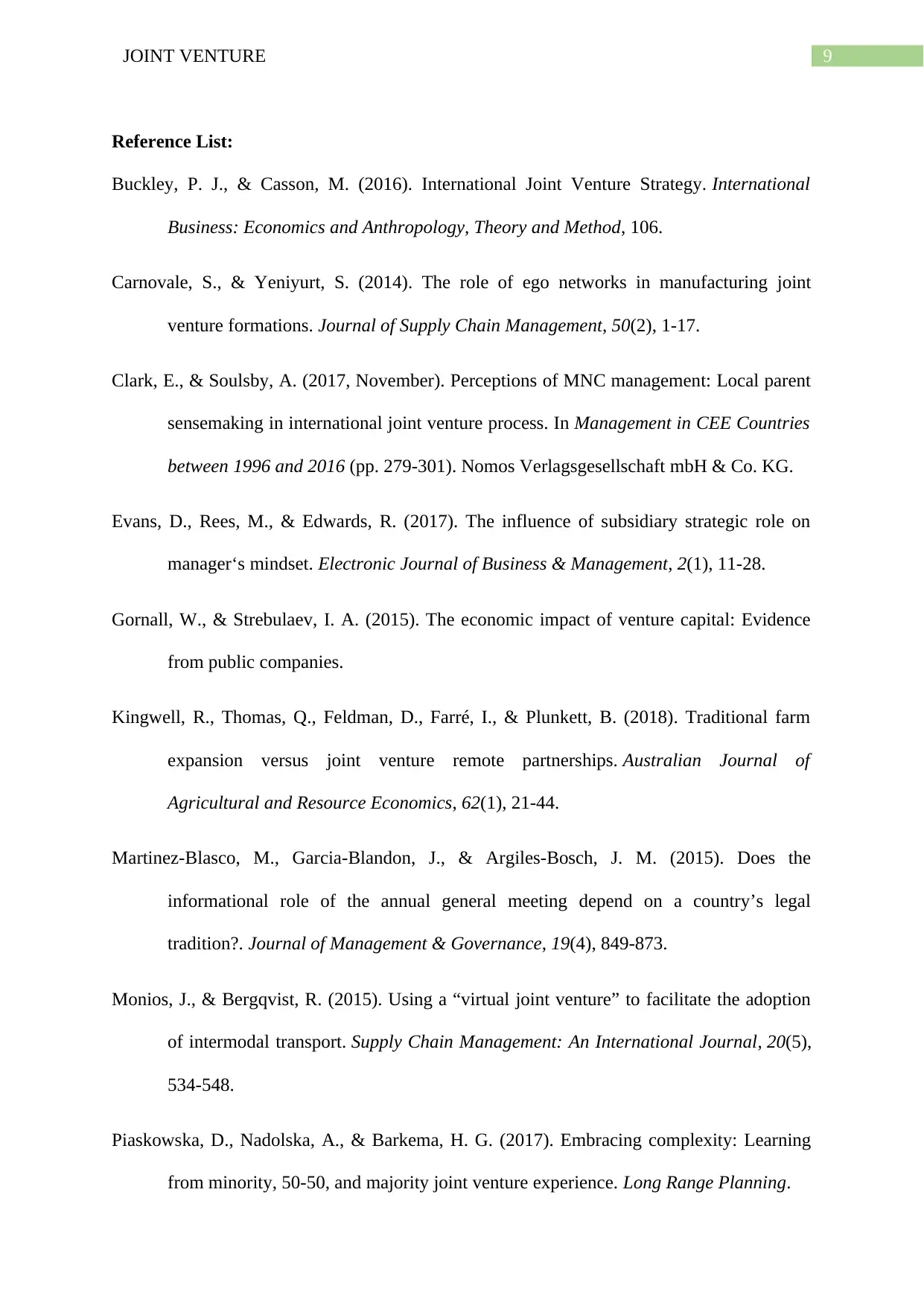
9JOINT VENTURE
Reference List:
Buckley, P. J., & Casson, M. (2016). International Joint Venture Strategy. International
Business: Economics and Anthropology, Theory and Method, 106.
Carnovale, S., & Yeniyurt, S. (2014). The role of ego networks in manufacturing joint
venture formations. Journal of Supply Chain Management, 50(2), 1-17.
Clark, E., & Soulsby, A. (2017, November). Perceptions of MNC management: Local parent
sensemaking in international joint venture process. In Management in CEE Countries
between 1996 and 2016 (pp. 279-301). Nomos Verlagsgesellschaft mbH & Co. KG.
Evans, D., Rees, M., & Edwards, R. (2017). The influence of subsidiary strategic role on
manager‘s mindset. Electronic Journal of Business & Management, 2(1), 11-28.
Gornall, W., & Strebulaev, I. A. (2015). The economic impact of venture capital: Evidence
from public companies.
Kingwell, R., Thomas, Q., Feldman, D., Farré, I., & Plunkett, B. (2018). Traditional farm
expansion versus joint venture remote partnerships. Australian Journal of
Agricultural and Resource Economics, 62(1), 21-44.
Martinez-Blasco, M., Garcia-Blandon, J., & Argiles-Bosch, J. M. (2015). Does the
informational role of the annual general meeting depend on a country’s legal
tradition?. Journal of Management & Governance, 19(4), 849-873.
Monios, J., & Bergqvist, R. (2015). Using a “virtual joint venture” to facilitate the adoption
of intermodal transport. Supply Chain Management: An International Journal, 20(5),
534-548.
Piaskowska, D., Nadolska, A., & Barkema, H. G. (2017). Embracing complexity: Learning
from minority, 50-50, and majority joint venture experience. Long Range Planning.
Reference List:
Buckley, P. J., & Casson, M. (2016). International Joint Venture Strategy. International
Business: Economics and Anthropology, Theory and Method, 106.
Carnovale, S., & Yeniyurt, S. (2014). The role of ego networks in manufacturing joint
venture formations. Journal of Supply Chain Management, 50(2), 1-17.
Clark, E., & Soulsby, A. (2017, November). Perceptions of MNC management: Local parent
sensemaking in international joint venture process. In Management in CEE Countries
between 1996 and 2016 (pp. 279-301). Nomos Verlagsgesellschaft mbH & Co. KG.
Evans, D., Rees, M., & Edwards, R. (2017). The influence of subsidiary strategic role on
manager‘s mindset. Electronic Journal of Business & Management, 2(1), 11-28.
Gornall, W., & Strebulaev, I. A. (2015). The economic impact of venture capital: Evidence
from public companies.
Kingwell, R., Thomas, Q., Feldman, D., Farré, I., & Plunkett, B. (2018). Traditional farm
expansion versus joint venture remote partnerships. Australian Journal of
Agricultural and Resource Economics, 62(1), 21-44.
Martinez-Blasco, M., Garcia-Blandon, J., & Argiles-Bosch, J. M. (2015). Does the
informational role of the annual general meeting depend on a country’s legal
tradition?. Journal of Management & Governance, 19(4), 849-873.
Monios, J., & Bergqvist, R. (2015). Using a “virtual joint venture” to facilitate the adoption
of intermodal transport. Supply Chain Management: An International Journal, 20(5),
534-548.
Piaskowska, D., Nadolska, A., & Barkema, H. G. (2017). Embracing complexity: Learning
from minority, 50-50, and majority joint venture experience. Long Range Planning.
Paraphrase This Document
Need a fresh take? Get an instant paraphrase of this document with our AI Paraphraser
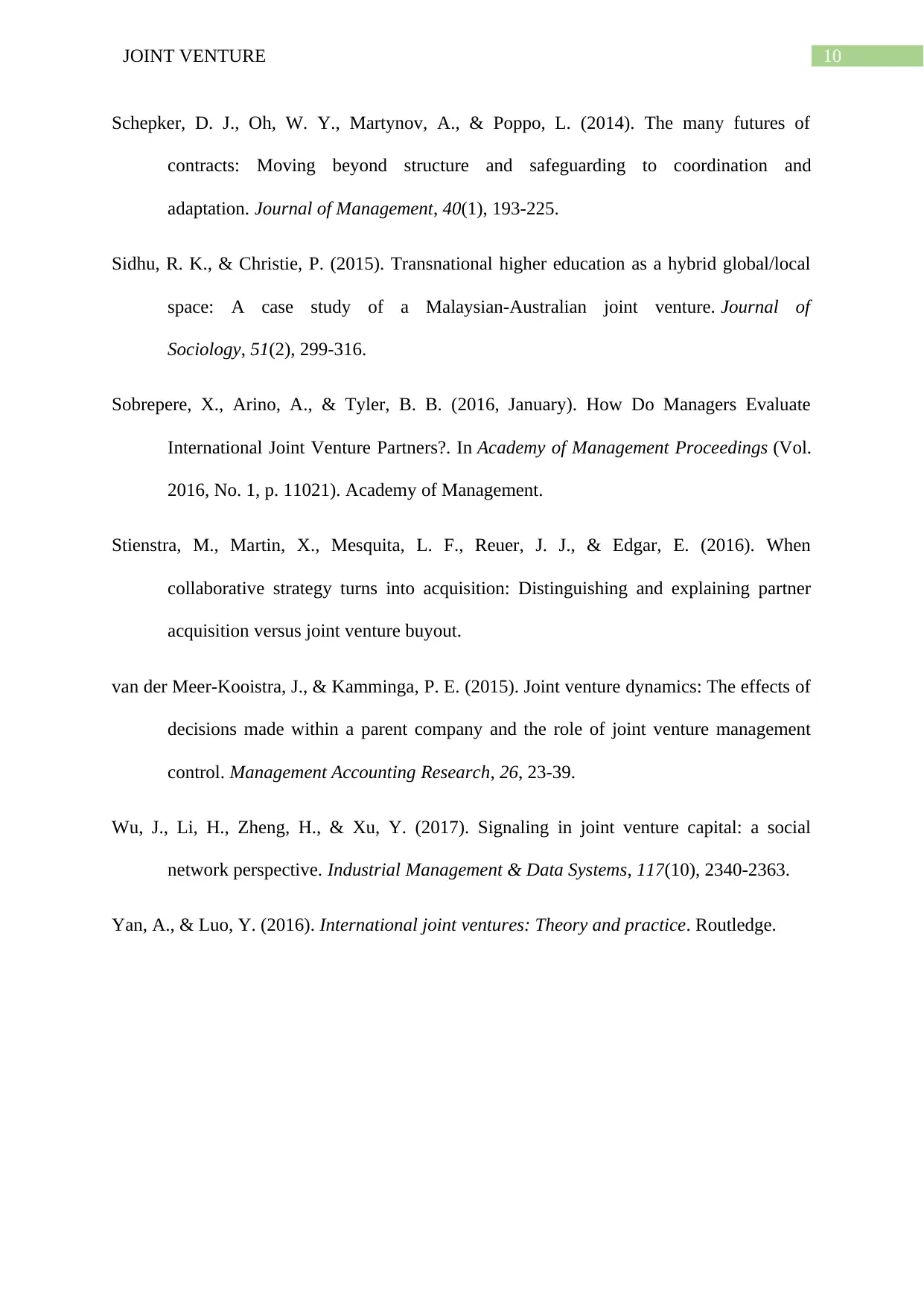
10JOINT VENTURE
Schepker, D. J., Oh, W. Y., Martynov, A., & Poppo, L. (2014). The many futures of
contracts: Moving beyond structure and safeguarding to coordination and
adaptation. Journal of Management, 40(1), 193-225.
Sidhu, R. K., & Christie, P. (2015). Transnational higher education as a hybrid global/local
space: A case study of a Malaysian-Australian joint venture. Journal of
Sociology, 51(2), 299-316.
Sobrepere, X., Arino, A., & Tyler, B. B. (2016, January). How Do Managers Evaluate
International Joint Venture Partners?. In Academy of Management Proceedings (Vol.
2016, No. 1, p. 11021). Academy of Management.
Stienstra, M., Martin, X., Mesquita, L. F., Reuer, J. J., & Edgar, E. (2016). When
collaborative strategy turns into acquisition: Distinguishing and explaining partner
acquisition versus joint venture buyout.
van der Meer-Kooistra, J., & Kamminga, P. E. (2015). Joint venture dynamics: The effects of
decisions made within a parent company and the role of joint venture management
control. Management Accounting Research, 26, 23-39.
Wu, J., Li, H., Zheng, H., & Xu, Y. (2017). Signaling in joint venture capital: a social
network perspective. Industrial Management & Data Systems, 117(10), 2340-2363.
Yan, A., & Luo, Y. (2016). International joint ventures: Theory and practice. Routledge.
Schepker, D. J., Oh, W. Y., Martynov, A., & Poppo, L. (2014). The many futures of
contracts: Moving beyond structure and safeguarding to coordination and
adaptation. Journal of Management, 40(1), 193-225.
Sidhu, R. K., & Christie, P. (2015). Transnational higher education as a hybrid global/local
space: A case study of a Malaysian-Australian joint venture. Journal of
Sociology, 51(2), 299-316.
Sobrepere, X., Arino, A., & Tyler, B. B. (2016, January). How Do Managers Evaluate
International Joint Venture Partners?. In Academy of Management Proceedings (Vol.
2016, No. 1, p. 11021). Academy of Management.
Stienstra, M., Martin, X., Mesquita, L. F., Reuer, J. J., & Edgar, E. (2016). When
collaborative strategy turns into acquisition: Distinguishing and explaining partner
acquisition versus joint venture buyout.
van der Meer-Kooistra, J., & Kamminga, P. E. (2015). Joint venture dynamics: The effects of
decisions made within a parent company and the role of joint venture management
control. Management Accounting Research, 26, 23-39.
Wu, J., Li, H., Zheng, H., & Xu, Y. (2017). Signaling in joint venture capital: a social
network perspective. Industrial Management & Data Systems, 117(10), 2340-2363.
Yan, A., & Luo, Y. (2016). International joint ventures: Theory and practice. Routledge.

11JOINT VENTURE
⊘ This is a preview!⊘
Do you want full access?
Subscribe today to unlock all pages.

Trusted by 1+ million students worldwide
1 out of 12
Your All-in-One AI-Powered Toolkit for Academic Success.
+13062052269
info@desklib.com
Available 24*7 on WhatsApp / Email
![[object Object]](/_next/static/media/star-bottom.7253800d.svg)
Unlock your academic potential
Copyright © 2020–2025 A2Z Services. All Rights Reserved. Developed and managed by ZUCOL.
